Temporal and Spatial Pattern Evolution and Influencing Factors of the National Comprehensive Disaster-Reduction Demonstration Community in China
Abstract
:1. Introduction
2. Literature Review
2.1. Community-Based Disaster Mitigation (CBDM)
2.2. Path for CBDM
3. Materials and Methods
3.1. Data
3.2. Methodology
3.2.1. Framework
3.2.2. Correlation Analysis
4. Results
4.1. Spatial–Temporal Pattern of CDRDC
4.1.1. Temporal Pattern of CDRDC
4.1.2. Spatial Pattern of CDRDC
4.2. Spatial Correlation of CDRDCs with Influencing Factors
4.3. Theoretical Distribution and the Key Development Areas of CDRDC
5. Discussion
5.1. Influencing Factors for CDRDC
5.2. Countermeasures for CBDM
5.3. Limitations
6. Conclusions
Author Contributions
Funding
Institutional Review Board Statement
Informed Consent Statement
Data Availability Statement
Acknowledgments
Conflicts of Interest
References
- Li, B.Y.; Li, J.Z.; Wang, J.J. Areal association of natural hazard in China. Acta Geogr. Sin. 1996, 51, 1–11. [Google Scholar] [CrossRef]
- IPCC. Climate Change 2021: The Physical Science Basis. Contribution of Working Group I to the Sixth Assessment Report of the Intergovernmental Panel on Climate Change; Cambridge University Press: Cambridge, UK, 2021. [Google Scholar]
- Wu, J.Y.; Ni, W.; Yang, S.N. The development and effectiveness assessment of comprehensive disaster reduction demonstration community in China. J. Catastrophol. 2019, 34, 184–188. [Google Scholar] [CrossRef]
- National Disaster Reduction Center of China (NDRCC). The Ministry of Emergency Management Released the National Natural Disaster Situation in China. Available online: http://www.ndrcc.org.cn/zqtj/25017.jhtml (accessed on 13 June 2022).
- Federal Emergency Management Agency (FEMA). Building a Disaster Resistant Community: Project Impact; FEMA: Washington, DC, USA, 1997. Available online: https://eric.ed.gov/?id=ed422712 (accessed on 16 November 2022).
- Baudoin, M.; Henly-Shepard, S.; Fernando, N.; Sitati, A.; Zommers, Z. From top-down to “community-centric” approaches to early warning systems: Exploring pathways to improve disaster risk reduction through community participation. Int. J. Disaster Risk Sci. 2016, 7, 163–174. [Google Scholar] [CrossRef] [Green Version]
- Ohgai, A.; Gohnai, Y.; Watanabe, K. Cellular automata modeling of fire spread in built-up areas—A tool to aid community-based planning for disaster mitigation. Comput. Environ. Urban Syst. 2007, 31, 441–460. [Google Scholar] [CrossRef]
- Nakahara, S. Lessons learnt from the recent tsunami in Japan: Necessity of epidemiological evidence to strengthen community-based preparation and emergency response plans. Inj. Prev. 2011, 17, 361–364. [Google Scholar] [CrossRef] [Green Version]
- Tanwattana, P. Systematizing Community-Based Disaster Risk Management (CBDRM): Case of urban flood-prone community in Thailand upstream area. Int. J. Disaster Risk Reduct. 2018, 28, 798–812. [Google Scholar] [CrossRef]
- Maskrey, A. Disaster Mitigation: A Community Based Approach; Oxfam: Oxford, UK, 1989; Available online: http://hdl.handle.net/10546/121119 (accessed on 16 November 2022).
- Chen, C.Y.; Huang, W.L. Land use change and landslide characteristics analysis for community-based disaster mitigation. Environ. Monit. Assess 2013, 185, 4125–4139. [Google Scholar] [CrossRef]
- Murosaki, Y. Disaster Prevention State of Communities in Japan; Kobe University: Kobe, Japan, 1999. [Google Scholar]
- Kong, F. Perspective on capacity building and regional cooperation in disaster prevention and relief of urban and rural grassroots communities. J. Cap. Norm. Univ. (Nat. Sci. Ed.) 2019, 40, 89–96. (In Chinese) [Google Scholar] [CrossRef]
- Choi, Y. Research for Evaluation Method of Urban Disaster Prevention Community Considered Human Ware. Int. J. Urban Sci. 2005, 9, 131–143. [Google Scholar] [CrossRef]
- Hosseini, K.A.; Izadkhah, Y.O. From “Earthquake and safety” school drills to “safe school-resilient communities”: A continuous attempt for promoting community-based disaster risk management in Iran. Int. J. Disaster Risk Reduct. 2020, 45, 101512. [Google Scholar] [CrossRef]
- Sarabia, M.M.; Kägi, A.; Davison, A.C.; Banwell, N.; Montes, C.; Aebischer, C.; Hostettler, S. The challenges of impact evaluation: Attempting to measure the effectiveness of community-based disaster risk management. Int. J. Disaster Risk Reduct. 2020, 49, 101732. [Google Scholar] [CrossRef]
- Räsänen, A.; Lein, H.; Bird, D.; Setten, G. Conceptualizing community in disaster risk management. Int. J. Disaster Risk Reduct. 2020, 45, 101485. [Google Scholar] [CrossRef]
- Seddiky, M.A.; Giggins, H.; Gajendran, T. International principles of disaster risk reduction informing NGOs strategies for community based DRR mainstreaming: The Bangladesh context. Int. J. Disaster Risk Reduct. 2020, 48, 101580. [Google Scholar] [CrossRef]
- Liu, Y.; Yin, K.L.; Chen, L.X.; Wang, W.; Liu, Y.L. A community-based disaster risk reduction system in Wanzhou, China. Int. J. Disaster Risk Reduct. 2016, 19, 379–389. [Google Scholar] [CrossRef]
- Klein, J.A.; Tucker, C.M.; Steger, C.E.; Nolin, A.; Reid, R.; Hopping, K.A.; Yeh, E.T.; Pradhan, M.S.; Taber, A.; Molden, D. An integrated community and ecosystem-based approach to disaster risk reduction in mountain systems. Environ. Sci. Policy 2019, 94, 143–152. [Google Scholar] [CrossRef]
- Fraser, T. Japanese social capital and social vulnerability indices: Measuring drivers of community resilience 2000–2017. Int. J. Disaster Risk Reduct. 2021, 52, 101965. [Google Scholar] [CrossRef]
- Imperiale, A.J.; Vanclay, F. Conceptualizing community resilience and the social dimensions of risk to overcome barriers to disaster risk reduction and sustainable development. Sustain. Dev. 2021, 29, 891–905. [Google Scholar] [CrossRef]
- Robertson, T.; Docherty, P.; Millar, F.; Ruck, A.; Engstrom, S. Theory and practice of building community resilience to extreme events. Int. J. Disaster Risk Reduct. 2021, 59, 102253. [Google Scholar] [CrossRef]
- Yin, Z.E.; Yin, J.; Xu, S.; Wen, J. Community-based scenario modelling and disaster risk assessment of urban rainstorm waterlogging. J. Geogr. Sci. 2011, 21, 274–284. [Google Scholar] [CrossRef]
- Rana, I.A.; Routray, J.K. Integrated methodology for flood risk assessment and application in urban communities of Pakistan. Nat. Hazards 2018, 91, 239–266. [Google Scholar] [CrossRef]
- Islam, M.; Malak, M.; Islam, M.N. Community-based disaster risk and vulnerability models of a coastal municipality in Bangladesh. Nat. Hazards 2013, 69, 2083–2103. [Google Scholar] [CrossRef]
- De Silva, M.; Kawasaki, A. Socioeconomic vulnerability to disaster risk: A case study of flood and drought impact in a rural Sri Lankan community. Ecol. Econ. 2018, 152, 131–140. [Google Scholar] [CrossRef]
- Wang, X.X.; Shi, R.T.; Lu, Y.T.; Zhou, Y. Fuzzy comprehensive evaluation of the disaster reduction ability of an ethnic minority accumulation area based on an analytic hierarchy process. Environ. Ecol. Stat. 2019, 26, 239–258. [Google Scholar] [CrossRef]
- Chou, J.S.; Yang, K.H.; Ren, T.C. Ex-post evaluation of preparedness education in disaster prevention, mitigation and response. Int. J. Disaster Risk Reduct. 2015, 12, 188–201. [Google Scholar] [CrossRef]
- Jamshed, A.; Rana, I.A.; Mirza, U.M.; Birkmann, J. Assessing relationship between vulnerability and capacity: An empirical study on rural flooding in Pakistan. Int. J. Disaster Risk Reduct. 2019, 36, 101109. [Google Scholar] [CrossRef]
- Duan, R.R.; Liu, J.; Wang, C.K.; Wei, G. Influencing factors of public participation in meteorological disaster prevention and mitigation. Sustainability 2020, 12, 3108. [Google Scholar] [CrossRef] [Green Version]
- Hamideh, S. Opportunities and challenges of public participation in post-disaster recovery planning: Lessons from Galveston, TX. Nat. Hazards Rev. 2020, 21, 5020009. [Google Scholar] [CrossRef]
- Li, P.; Jing, T.C.; Wei, D.A.; Ying, L.A. Farmers’ participation in community-based disaster management: The role of trust, place attachment and self-efficacy. Int. J. Disaster Risk Reduct. 2020, 51, 101895. [Google Scholar] [CrossRef]
- Ruszczyk, H.A.; Upadhyay, B.K.; Kwong, Y.M.C.; Khanal, O.; Bracken, L.J.; Pandit, S.; Bastola, R. Empowering women through participatory action research in community-based disaster risk reduction efforts. Int. J. Disaster Risk Reduct. 2020, 51, 101763. [Google Scholar] [CrossRef]
- Ramalho, J. Empowerment in the era of resilience-building: Gendered participation in community-based (disaster) risk management in the Philippines. Int. Dev. Plann. Rev. 2019, 41, 129–149. [Google Scholar] [CrossRef]
- Ma, Y.J.; Xu, W.; Qin, L.J.; Zhao, X.J. Site selection models in natural disaster shelters: A review. Sustainability 2019, 11, 399. [Google Scholar] [CrossRef] [Green Version]
- Boonmee, C.; Arimura, M.; Asada, T. Facility location optimization model for emergency humanitarian logistics. Int. J. Disaster Risk Reduct. 2017, 24, 485–498. [Google Scholar] [CrossRef]
- Hu, F.; Xu, W.; Li, X. A modified particle swarm optimization algorithm for optimal allocation of earthquake emergency shelters. Int. J. Geogr. Inf. Sci. 2012, 26, 1643–1666. [Google Scholar] [CrossRef]
- Bozorgi-Amiri, A.; Jabalameli, M.S.; Alinaghian, M.; Heydari, M. A modified particle swarm optimization for disaster relief logistics under uncertain environment. Int. J. Adv. Manuf. Technol. 2012, 60, 357–371. [Google Scholar] [CrossRef]
- Zhao, X.J.; Xu, W.; Ma, Y.J.; Qin, L.J.; Zhang, J.L.; Wang, Y. Relationships between evacuation population size, earthquake emergency shelter capacity, and evacuation time. Int. J. Disaster Risk Sci. 2017, 8, 457–470. [Google Scholar] [CrossRef] [Green Version]
- Xu, W.; Ma, Y.J.; Zhao, X.J.; Li, Y.; Qin, L.J.; Du, J. A comparison of scenario-based hybrid bilevel and multi-objective location-allocation models for earthquake emergency shelters: A case study in the central area of Beijing, China. Int. J. Geogr. Inf. Sci. 2018, 32, 236–256. [Google Scholar] [CrossRef]
- Xu, W.; Zhao, X.J.; Ma, Y.J.; Li, Y.; Qin, L.J.; Wang, Y.; Du, J. A multi-objective optimization based method for evaluating earthquake shelter location-allocation. Geomat. Nat. Hazards Risk 2018, 9, 662–677. [Google Scholar] [CrossRef] [Green Version]
- Ma, Y.J.; Xu, W.; Qin, L.J.; Zhao, X.J.; Du, J. Hierarchical supplement location-allocation optimization for disaster supplies warehouse in the Beijing-Tianjin-Hebei region of China. Geomat. Nat. Hazards Risk 2019, 10, 102–117. [Google Scholar] [CrossRef] [Green Version]
- Ma, Y.J.; Liu, B.Y.; Zhang, K.W.; Yang, Y.Y. Incorporating multi-criteria suitability evaluation into multi-objective location-allocation optimization comparison for earthquake emergency shelters. Geomat. Nat. Hazards Risk 2022, 13, 2333–2355. [Google Scholar] [CrossRef]
- Kongsomsaksakul, S.; Yang, C.; Chen, A. Shelter location-allocation model for flood evacuation planning. J. East. Asia Soc. Transp. Stud. 2005, 6, 4237–4252. [Google Scholar] [CrossRef]
- Nolz, P.C.; Semet, F.; Doerner, K.F. Risk approaches for delivering disaster relief supplies. OR Spectr. 2011, 33, 543–569. [Google Scholar] [CrossRef] [Green Version]
- Hu, F.; Yang, S.; Xu, W. A non-dominated sorting genetic algorithm for the location and districting planning of earthquake shelters. Int. J. Geogr. Inf. Sci. 2014, 28, 1482–1501. [Google Scholar] [CrossRef]
- Zhao, M.; Chen, Q.W.; Ma, J.; Cai, D. Optimizing temporary rescue facility locations for large-scale urban environmental emergencies to improve public safety. J. Environ. Inform. 2017, 29, 61–73. [Google Scholar] [CrossRef] [Green Version]
- Gharib, Z.; Yazdani, M.; Bozorgi-Amiri, A.; Tavakkoli-Moghaddam, R.; Taghipourian, M.J. Developing an integrated model for planning the delivery of construction materials to post-disaster reconstruction projects. J. Comput. Des. Eng. 2022, 9, 1135–1156. [Google Scholar] [CrossRef]
- Gama, M.; Santos, B.F.; Scaparra, M.P. A multi-period shelter location-allocation model with evacuation orders for flood disasters. EURO J. Comput. Optim. 2015, 4, 1–25. [Google Scholar] [CrossRef]
- Ng, M.W.; Park, J.; Waller, S.T. A hybrid bilevel model for the optimal shelter assignment in emergency evacuations. Comput.-Aided Civ. Infrastruct. Eng. 2010, 25, 547–556. [Google Scholar] [CrossRef]
- Gharib, Z.; Tavakkoli-Moghaddam, R.; Bozorgi-Amiri, A.; Yazdani, M. Post-disaster temporary shelters distribution after a large-scale disaster: An integrated model. Buildings 2022, 12, 414. [Google Scholar] [CrossRef]
- Du, S. Urban Emergency Shelter Site Selection Method Based on ant Colony Algorithm; Shanghai Normal University: Shanghai, China, 2018. (In Chinese) [Google Scholar]
- Zhou, H.J.; Zhang, W.X.; Lei, Y.D.; Yin, W.X. Temporal and spatial pattern of national model community of comprehensive disaster-reduction in China. Geogr. Res. 2013, 32, 1077–1083. (In Chinese) [Google Scholar]
- Shi, P.J. Atlas of Natural Disaster Risk of China; Science Press: Beijing, China, 2011. [Google Scholar]
- Wang, M.H. China Statistical Yearbook 2021 (County-Level); China Statistics Press: Beijing, China, 2021. [Google Scholar] [CrossRef]
- Zhou, H.J.; Zhang, W.X. Comparison of community disaster risk management model—Analysis from Chinese comprehensive disaster-reduction demonstration communities and CBDRM communities. J. Catastrophol. 2013, 28, 120–126. (In Chinese) [Google Scholar]
- Teets, J.C. Post-earthquake relief and reconstruction efforts: The emergence of civil society in China? China Q. 2009, 198, 330–347. [Google Scholar] [CrossRef] [Green Version]
- Espia, J.C.P.; Fernandez, P., Jr. Insiders and outsiders: Local government and NGO engagement in disaster response in Guimaras, Philippines. Disasters 2015, 39, 51–68. [Google Scholar] [CrossRef] [PubMed]
- Maiers, C.; Reynolds, M.; Haselkorn, M. Challenges to effective information and communication systems in humanitarian relief organizations. In IPCC 2005, Proceedings of the International Professional Communication Conference, Limerick, Ireland, 10–13 July 2005; IEEE: Piscataway, NJ, USA, 2005; pp. 82–91. [Google Scholar] [CrossRef]
- Shittu, E.; Parker, G.; Mock, N. Improving communication resilience for effective disaster relief operations. Environ. Syst. Decis. 2018, 38, 379–397. [Google Scholar] [CrossRef]
- Lu, Y.; Zhan, C.Y.; Li, R.; Su, M. An NGO disaster relief network for small and medium-scale natural hazards in China. Nat. Hazards 2021, 106, 2689–2709. [Google Scholar] [CrossRef] [PubMed]
- Hillig, Z.; Connell, J. Social capital in a crisis: NGO responses to the 2015 Nepalese earthquakes. Asia Pac. Viewp. 2018, 59, 309–322. [Google Scholar] [CrossRef]
- Zhao, L.J.; Wang, X.X. Natural Disaster Reduction, Aid Ability Construction Research Based on analysis of Hubei province. In Proceedings of the 2012 International Conference on Public Management (ICPM-2012), Bali, Indonesia, 11–13 June 2012; Atlantis Press: Paris, France, 2012; pp. 389–394. [Google Scholar] [CrossRef]
- Shi, P.J. On the role of government in integrated disaster risk governance—Based on practices in China. Int. J. Disaster Risk Sci. 2012, 3, 139–146. [Google Scholar] [CrossRef]
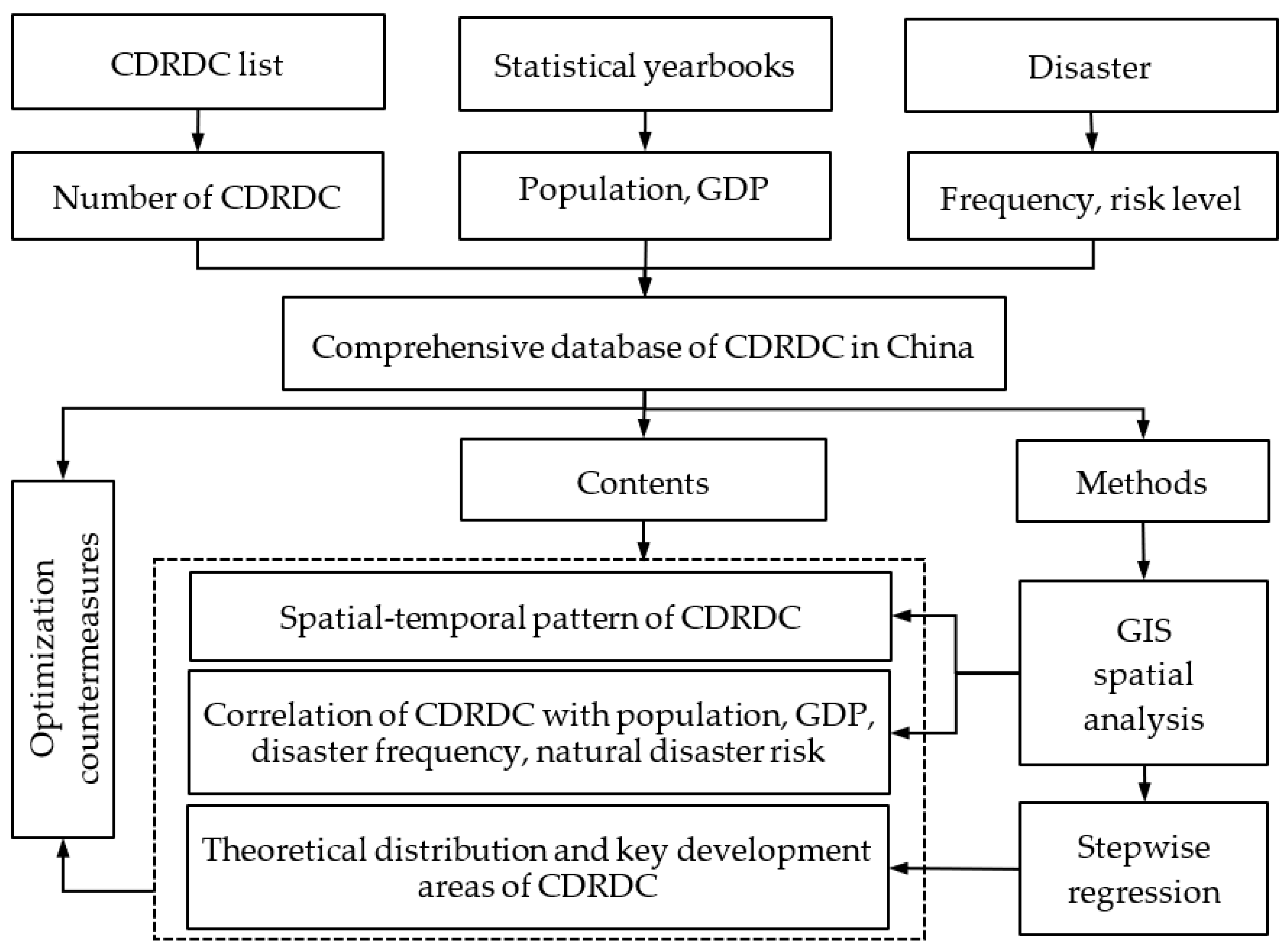
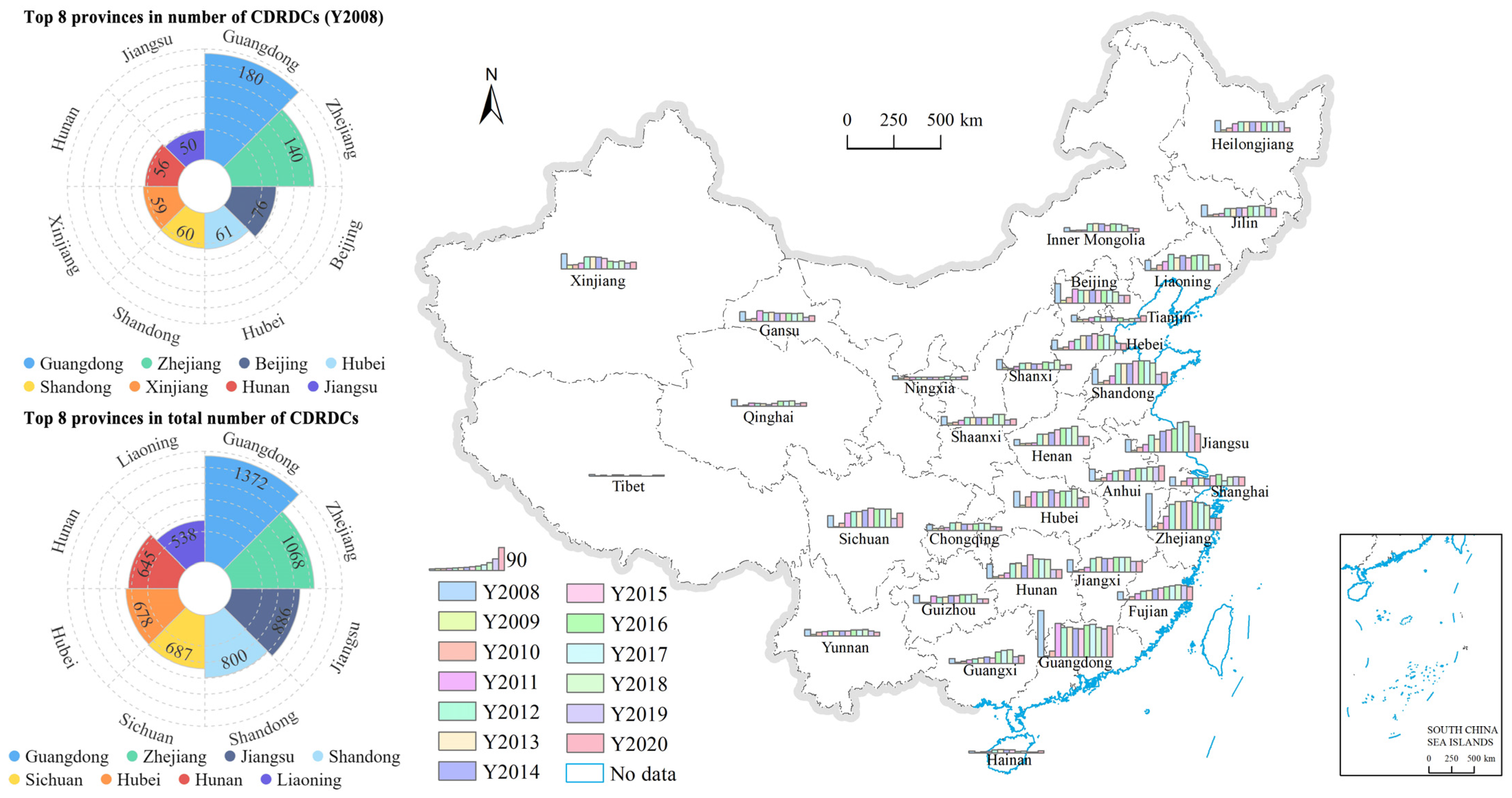
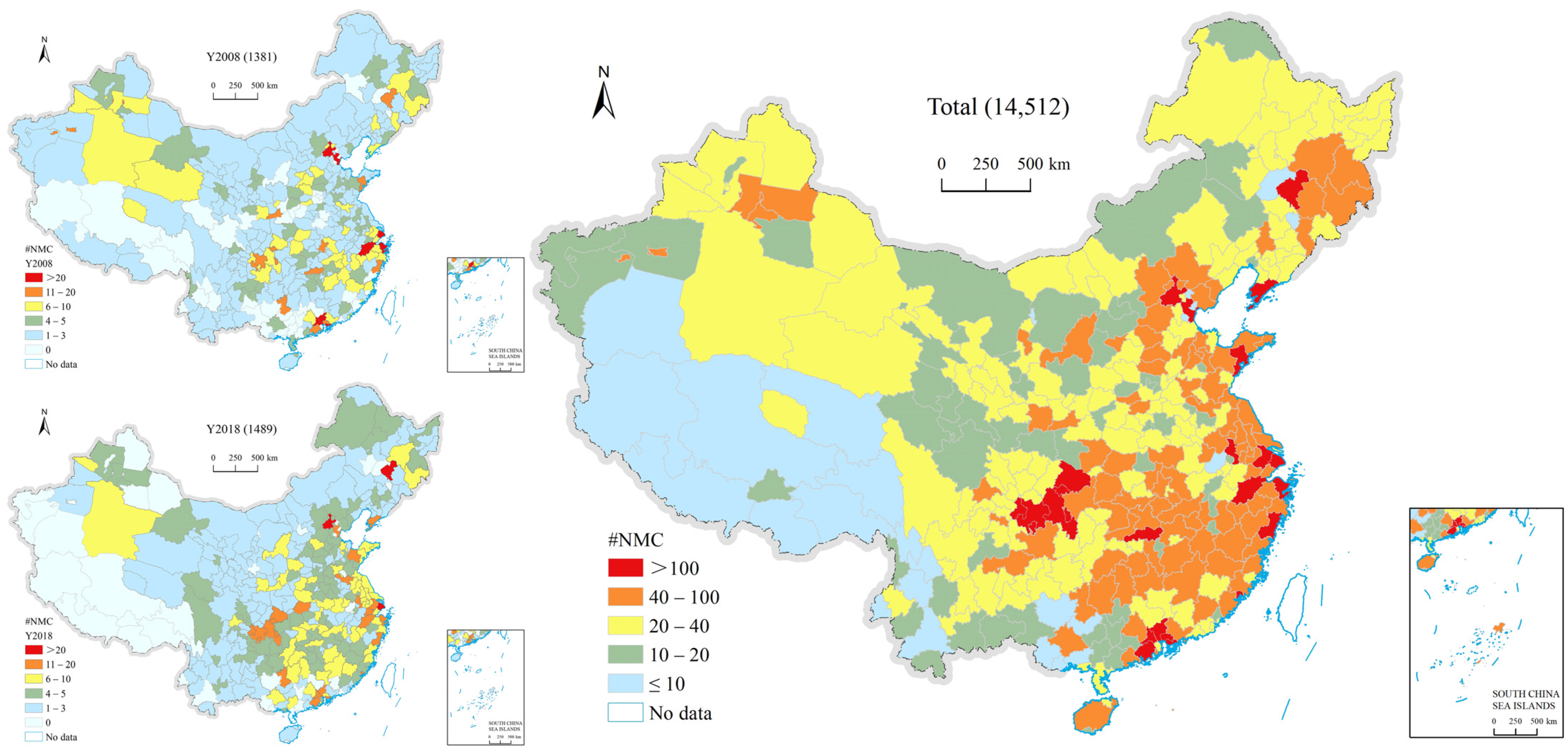
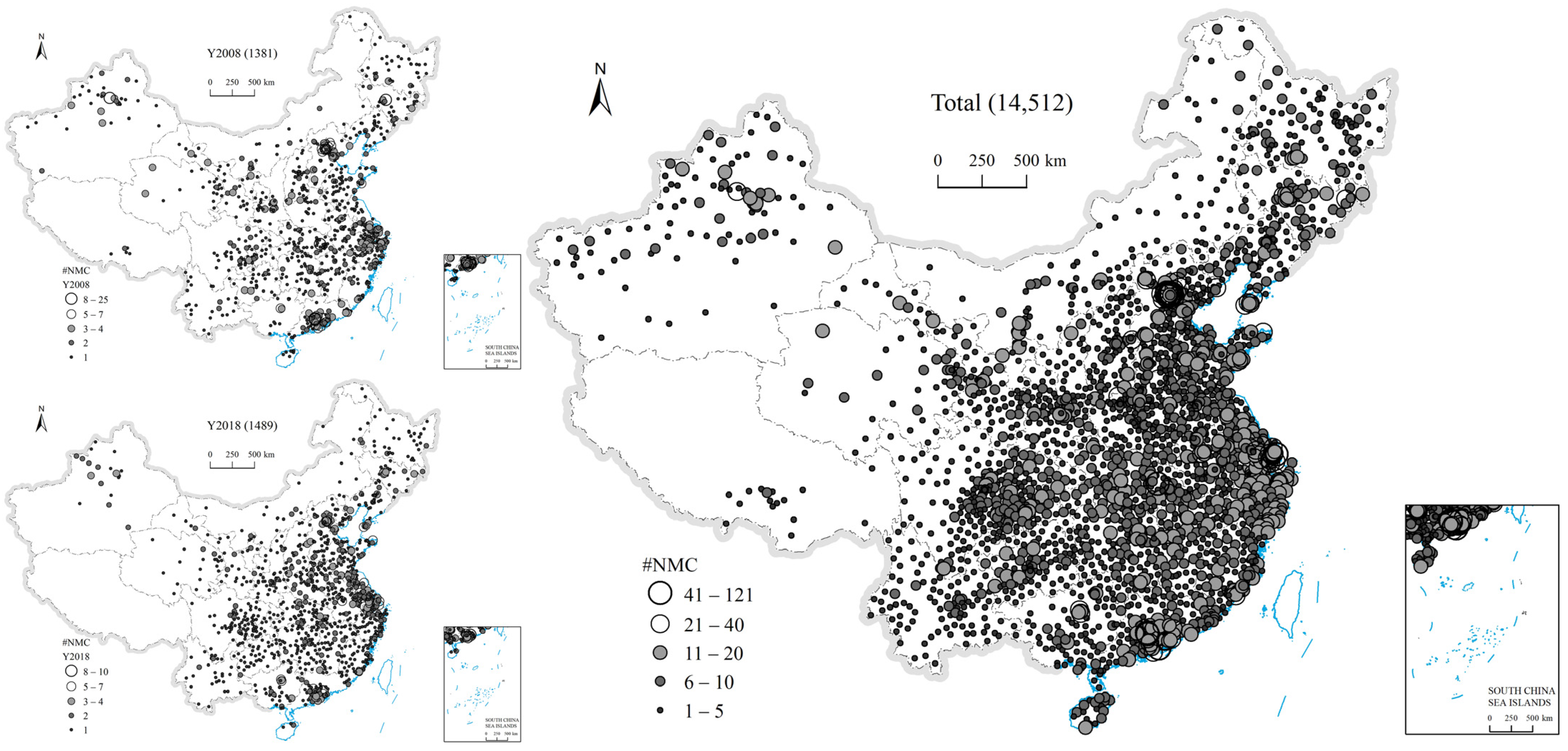
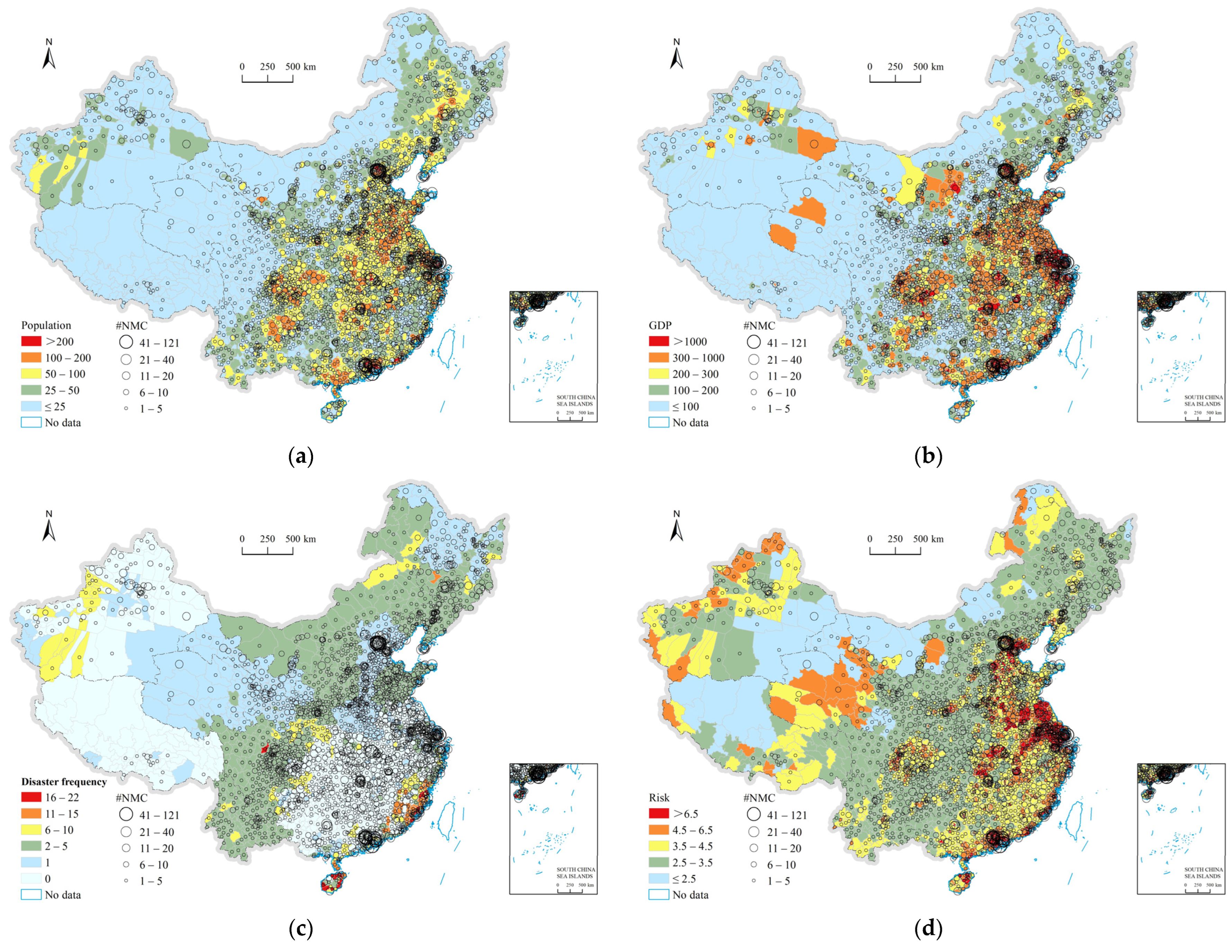
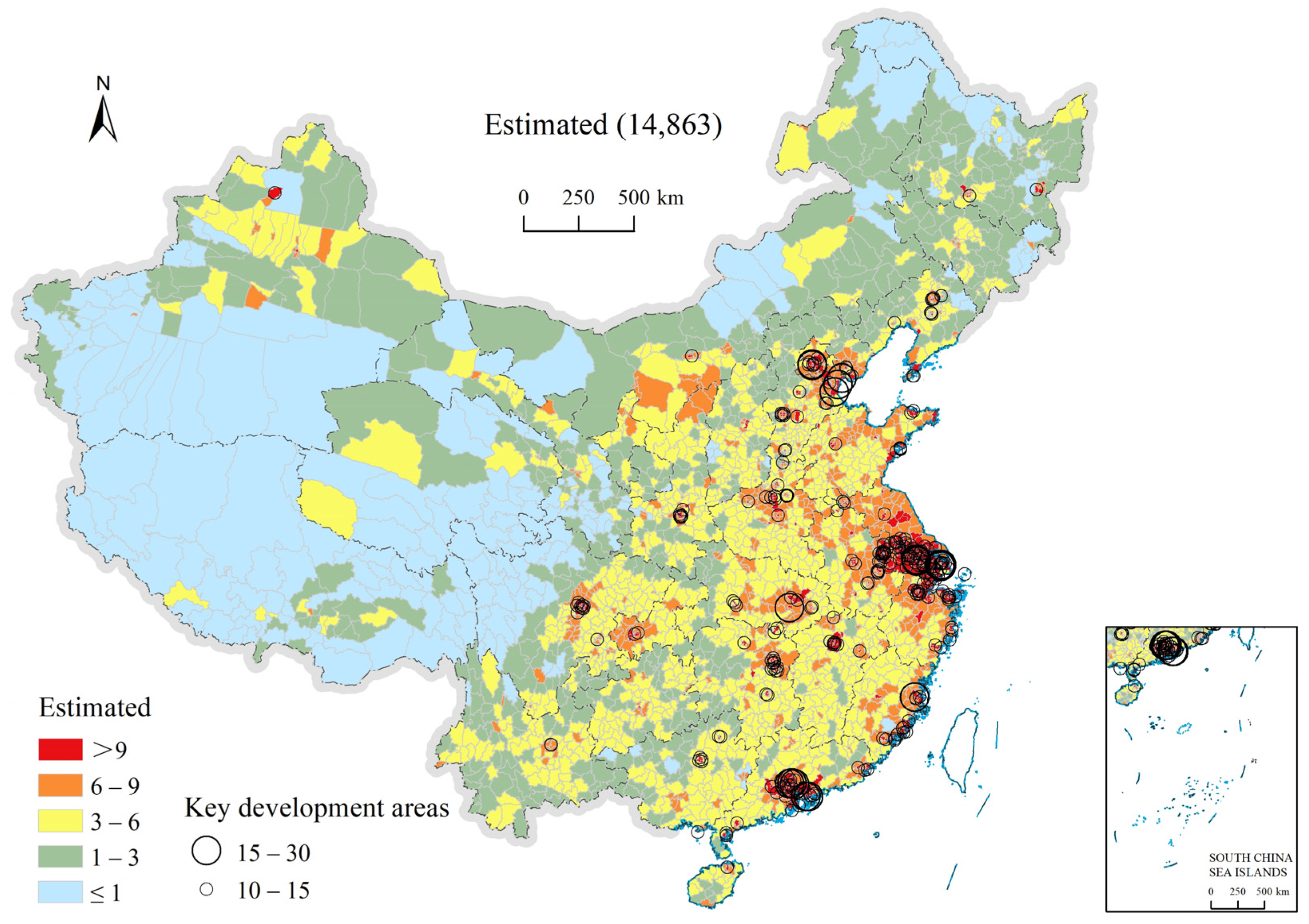
| Database | Data Description | Scale | Source | Year | Website/Reference |
|---|---|---|---|---|---|
| CDRDC list | Establishment time, community name | County | Ministry of Emergency Management of China | 2018–2020 | https://www.mem.gov.cn/gk/zfxxgkpt/fdzdgknr/202102/t20210207_379798.shtml (accessed on 16 November 2022) |
| Ministry of Civil Affairs;National Disaster Reduction Center of China | 2008–2017 | https://www.mca.gov.cn/article/xw/tzgg/201712/20171215006995.shtml (accessed on 16 November 2022); http://www.ndrcc.org.cn/tzgg/12297.jhtml (accessed on 16 November 2022) | |||
| Disaster frequency | Disaster time, location, type | County | Global disaster data platform | 2010–2020 | https://www.gddat.cn (accessed on 16 November 2022) |
| Natural disaster risk | Risk level of integrated natural disaster | County | Atlas of Natural Disaster Risk of China | 2011 | [55] |
| Socioeconomic data | GDP, population | County | China Statistical Yearbook 2021 (County-level) | 2020 | [56] |
| Province | Year | Total | ||||||||||||
|---|---|---|---|---|---|---|---|---|---|---|---|---|---|---|
| 2008 | 2009 | 2010 | 2011 | 2012 | 2013 | 2014 | 2015 | 2016 | 2017 | 2018 | 2019 | 2020 | ||
| Guangdong | 180 | 4 | 22 | 129 | 114 | 115 | 110 | 109 | 122 | 126 | 113 | 108 | 120 | 1372 |
| Zhejiang | 140 | 12 | 26 | 53 | 100 | 111 | 111 | 113 | 108 | 106 | 96 | 46 | 46 | 1068 |
| Jiangsu | 50 | 7 | 19 | 30 | 67 | 51 | 80 | 86 | 90 | 115 | 119 | 100 | 72 | 886 |
| Shandong | 60 | 8 | 15 | 34 | 80 | 80 | 80 | 90 | 91 | 92 | 83 | 40 | 47 | 800 |
| Sichuan | 46 | 2 | 16 | 55 | 62 | 62 | 66 | 75 | 71 | 71 | 71 | 35 | 55 | 687 |
| Hubei | 61 | 7 | 40 | 60 | 58 | 60 | 67 | 56 | 62 | 62 | 70 | 35 | 40 | 678 |
| Hunan | 56 | 6 | 12 | 21 | 57 | 60 | 50 | 91 | 75 | 74 | 73 | 35 | 35 | 645 |
| Liaoning | 39 | 7 | 21 | 34 | 63 | 49 | 57 | 49 | 57 | 60 | 59 | 20 | 23 | 538 |
| Henan | 23 | 7 | 8 | 10 | 44 | 44 | 49 | 60 | 66 | 66 | 74 | 35 | 36 | 522 |
| Jiangxi | 47 | 5 | 10 | 18 | 52 | 56 | 52 | 52 | 56 | 56 | 56 | 40 | 40 | 540 |
| Beijing | 76 | 10 | 21 | 55 | 50 | 50 | 50 | 50 | 50 | 50 | 44 | 30 | 30 | 566 |
| Anhui | 47 | 7 | 14 | 30 | 40 | 42 | 41 | 48 | 50 | 51 | 55 | 55 | 60 | 540 |
| Hebei | 38 | 6 | 10 | 33 | 40 | 55 | 55 | 63 | 56 | 60 | 54 | 25 | 24 | 519 |
| Fujian | 31 | 2 | 12 | 24 | 33 | 36 | 42 | 45 | 51 | 54 | 58 | 55 | 51 | 494 |
| Heilongjiang | 44 | 8 | 15 | 32 | 40 | 40 | 39 | 40 | 39 | 40 | 40 | 41 | 16 | 434 |
| Guangxi | 19 | 5 | 8 | 14 | 18 | 21 | 25 | 22 | 44 | 50 | 52 | 26 | 30 | 334 |
| Xinjiang | 59 | 14 | 16 | 22 | 46 | 46 | 45 | 40 | 29 | 27 | 30 | 22 | 25 | 421 |
| Jilin | 46 | 7 | 10 | 13 | 32 | 33 | 35 | 35 | 41 | 41 | 43 | 36 | 33 | 405 |
| Shanghai | 35 | 0 | 18 | 31 | 31 | 31 | 27 | 39 | 44 | 20 | 34 | 36 | 35 | 381 |
| Shaanxi | 34 | 7 | 11 | 19 | 30 | 30 | 30 | 30 | 30 | 42 | 42 | 20 | 23 | 348 |
| Gansu | 37 | 6 | 9 | 40 | 33 | 34 | 30 | 30 | 30 | 29 | 30 | 15 | 20 | 343 |
| Guizhou | 31 | 4 | 4 | 28 | 23 | 25 | 30 | 30 | 33 | 33 | 35 | 17 | 17 | 310 |
| Inner Mongolia | 17 | 5 | 6 | 7 | 31 | 32 | 31 | 25 | 31 | 30 | 25 | 15 | 13 | 268 |
| Chongqing | 22 | 7 | 8 | 11 | 29 | 31 | 25 | 24 | 26 | 28 | 27 | 15 | 14 | 267 |
| Shanxi | 38 | 7 | 4 | 11 | 23 | 24 | 20 | 20 | 28 | 26 | 35 | 15 | 18 | 269 |
| Yunnan | 25 | 6 | 15 | 17 | 20 | 20 | 20 | 20 | 23 | 23 | 24 | 20 | 14 | 247 |
| Tianjin | 25 | 7 | 9 | 15 | 18 | 15 | 19 | 11 | 13 | 7 | 11 | 12 | 22 | 184 |
| Qinghai | 27 | 2 | 6 | 13 | 12 | 10 | 7 | 12 | 20 | 20 | 22 | 10 | 14 | 175 |
| Ningxia | 15 | 6 | 10 | 10 | 10 | 10 | 10 | 10 | 10 | 14 | 10 | 10 | 13 | 138 |
| Hainan | 7 | 2 | 5 | 6 | 12 | 14 | 12 | 12 | 6 | 7 | 4 | 4 | 9 | 100 |
| Tibet | 6 | 1 | 3 | 0 | 5 | 5 | 0 | 3 | 3 | 0 | 0 | 3 | 4 | 33 |
| Total | 1381 | 184 | 403 | 875 | 1273 | 1292 | 1315 | 1390 | 1455 | 1480 | 1489 | 976 | 999 | 14,512 |
| City | Year | Total | ||||||||||||
|---|---|---|---|---|---|---|---|---|---|---|---|---|---|---|
| 2008 | 2009 | 2010 | 2011 | 2012 | 2013 | 2014 | 2015 | 2016 | 2017 | 2018 | 2019 | 2020 | ||
| Beijing | 67 | 10 | 19 | 51 | 46 | 46 | 46 | 46 | 48 | 47 | 40 | 28 | 27 | 521 |
| Shanghai | 35 | 0 | 17 | 30 | 30 | 29 | 23 | 36 | 40 | 18 | 30 | 34 | 32 | 354 |
| Ningbo | 36 | 4 | 10 | 17 | 21 | 21 | 21 | 18 | 17 | 18 | 15 | 6 | 6 | 210 |
| Guangzhou | 30 | 0 | 0 | 24 | 21 | 16 | 15 | 14 | 25 | 18 | 15 | 13 | 11 | 202 |
| Foshan | 39 | 0 | 6 | 19 | 26 | 17 | 13 | 13 | 10 | 16 | 15 | 10 | 5 | 189 |
| Hangzhou | 41 | 1 | 2 | 14 | 15 | 17 | 16 | 16 | 16 | 16 | 16 | 8 | 8 | 186 |
| Tianjin | 25 | 6 | 9 | 15 | 17 | 15 | 18 | 11 | 13 | 7 | 11 | 19 | 19 | 185 |
| Shenzhen | 22 | 3 | 7 | 19 | 15 | 15 | 14 | 9 | 13 | 16 | 16 | 9 | 10 | 168 |
| Dalian | 6 | 0 | 5 | 6 | 20 | 19 | 20 | 20 | 20 | 20 | 20 | 0 | 0 | 156 |
| Chongqing municipal district | 16 | 5 | 3 | 6 | 21 | 21 | 13 | 12 | 13 | 14 | 13 | 10 | 5 | 152 |
| Wenzhou | 16 | 1 | 3 | 4 | 14 | 16 | 17 | 18 | 16 | 15 | 14 | 5 | 5 | 144 |
| Qingdao | 15 | 2 | 5 | 7 | 15 | 15 | 15 | 15 | 12 | 12 | 9 | 4 | 9 | 135 |
| Changchun | 18 | 2 | 1 | 3 | 9 | 8 | 6 | 6 | 12 | 17 | 23 | 8 | 12 | 125 |
| Dongguan | 14 | 0 | 0 | 20 | 13 | 9 | 10 | 10 | 10 | 10 | 10 | 8 | 7 | 121 |
| Nanjing | 5 | 1 | 4 | 4 | 8 | 4 | 10 | 12 | 15 | 15 | 12 | 13 | 12 | 115 |
| Suzhou | 9 | 0 | 4 | 6 | 9 | 1 | 9 | 15 | 15 | 15 | 14 | 11 | 7 | 115 |
| Chongqing municipal county | 6 | 2 | 5 | 5 | 8 | 10 | 12 | 12 | 13 | 14 | 14 | 5 | 9 | 115 |
| Changsha | 13 | 3 | 3 | 6 | 13 | 16 | 11 | 16 | 7 | 6 | 10 | 4 | 6 | 114 |
| Xiamen | 10 | 0 | 6 | 10 | 8 | 8 | 10 | 10 | 10 | 10 | 13 | 7 | 8 | 110 |
| Jiangmen | 15 | 0 | 2 | 0 | 5 | 7 | 8 | 8 | 11 | 11 | 16 | 11 | 7 | 101 |
| Total | 438 | 40 | 111 | 266 | 334 | 310 | 307 | 317 | 336 | 315 | 326 | 213 | 205 | 3518 |
| Region | Province | County | City | Total |
|---|---|---|---|---|
| Pearl River Delta | Guangdong | Dongguan City | Dongguan | 658 |
| Chancheng, Nanhai, Shunde and Sanshui Districts | Foshan | |||
| Xiangzhou and Jinwan Districts | Zhuhai | |||
| Baoan, Longgang, Nanshan and Futian Districts | Shenzhen | |||
| Huangpu, Tianhe and Panyu Districts | Guangzhou | |||
| Zhongshan City | Zhongshan | |||
| Huicheng District | Huizhou | |||
| Jianghai and Xinhui Districts | Jiangmen | |||
| Capital circle | Beijing | Chaoyang, Haidian, Dongcheng, Fengtai, Shijingshan, Xicheng, Shunyi, Daxing, Tongzhou, Fangshan, Miyun, Pinggu and Mentougou Districts | Beijing | 573 |
| Tianjin | Heping District | Tianjin | ||
| Hebei | Haigang District | Qinhuangdao | ||
| Qiaodong District | Zhangjiakou | |||
| Yangtze River Delta | Shanghai | Pudong New Area, Putuo, Jiading, Chongming, Qingpu, Yangpu, Hongkou, Fengxian, Changning, Songjiang and Jianshan Districts | Shanghai | 550 |
| Zhejiang | Yuyao City, Beilun and Yinzhou Districts, Cixi City | Ningbo | ||
| Xihu District | Hanghzou | |||
| Wuxing District, Changxing County | Huzhou | |||
| Jiangsu | Binhu and Xishan Districts | Wuxi | ||
| Anhui | Shushan District | Hefei | ||
| Xiangshan District | Huaibei | |||
| Other regions | 503 | |||
| Total | 2284 | |||
| Region | Province | City | County | Theoretical Number |
|---|---|---|---|---|
| Capital circle | Beijing | Beijing | Xicheng District | 30 |
| Tianjin | Tianjin | Hangu District | 18 | |
| Tanggu District | 17 | |||
| Dagang District | 17 | |||
| Yangtze River Delta | Shanghai | Shanghai | Huangpu District | 17 |
| Luwan District | 17 | |||
| Jing’an District | 17 | |||
| Changning District | 16 | |||
| Xuhui District | 15 | |||
| Jiangsu | Wuxi | Chongan DIstrict | 16 | |
| Nanchang District | 15 | |||
| Beitang District | 15 | |||
| Pearl River Delta | Guangdong | Shenzhen | Nanshan District | 16 |
| Futian District | 15 | |||
| Guangzhou | Yuexiu District | 16 | ||
| Tianhe District | 15 | |||
| Huangpu District | 15 | |||
| Provincial capital | Fujian | Fuzhou | Gulou District | 16 |
| Hubei | Wuhan | Hannan District | 15 |
Publisher’s Note: MDPI stays neutral with regard to jurisdictional claims in published maps and institutional affiliations. |
© 2022 by the authors. Licensee MDPI, Basel, Switzerland. This article is an open access article distributed under the terms and conditions of the Creative Commons Attribution (CC BY) license (https://creativecommons.org/licenses/by/4.0/).
Share and Cite
Ma, Y.; Chen, S.; Zhang, K.; Yang, Y. Temporal and Spatial Pattern Evolution and Influencing Factors of the National Comprehensive Disaster-Reduction Demonstration Community in China. Sustainability 2022, 14, 15238. https://doi.org/10.3390/su142215238
Ma Y, Chen S, Zhang K, Yang Y. Temporal and Spatial Pattern Evolution and Influencing Factors of the National Comprehensive Disaster-Reduction Demonstration Community in China. Sustainability. 2022; 14(22):15238. https://doi.org/10.3390/su142215238
Chicago/Turabian StyleMa, Yunjia, Sijia Chen, Kaiwen Zhang, and Yumeng Yang. 2022. "Temporal and Spatial Pattern Evolution and Influencing Factors of the National Comprehensive Disaster-Reduction Demonstration Community in China" Sustainability 14, no. 22: 15238. https://doi.org/10.3390/su142215238






